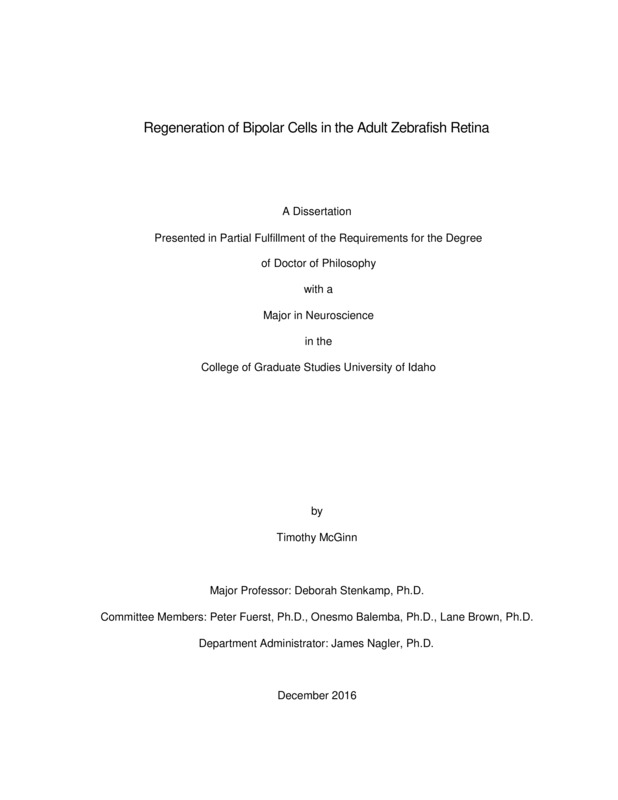Regeneration of Bipolar Cells In The Adult Zebrafish Retina
McGinn, Timothy Edward. (2016). Regeneration of Bipolar Cells In The Adult Zebrafish Retina. Theses and Dissertations Collection, University of Idaho Library Digital Collections. https://www.lib.uidaho.edu/digital/etd/items/mcginn_idaho_0089e_10988.html
- Title:
- Regeneration of Bipolar Cells In The Adult Zebrafish Retina
- Author:
- McGinn, Timothy Edward
- Date:
- 2016
- Embargo Remove Date:
- 2018-12-20
- Program:
- Neuroscience
- Subject Category:
- Neurosciences; Ophthalmology; Developmental biology
- Abstract:
-
Adult zebrafish are capable of generating new neurons in the central nervous system, including the retina. Results from previous studies have suggested that some, if not all, of these newly generated retinal neurons are functional and reform functional circuitry. The complexity of this circuitry and the ability of these newly formed neurons to recapitulate circuitry formed during development has not been studied. These previous studies also did not measure the morphology and types of connections made by these newly formed neurons and did not examine adult retinas. The studies of this dissertation measured the morphological and bipolar cell to photoreceptor connectivity patterns of bipolar cells that expressed yellow fluorescent protein driven by the nyctalopin promoter or expressed PKCα. We hypothesized that these bipolar cells would restore the sizes of their dendritic fields and restore connections with SWS2 (blue), RH2 (green), and LWS (red) cones over a 60 day time-course (when visually-mediated reflexes are regained).
I selectively lesioned the neurons of the inner retina, by using the neurotoxin ouabain. Results from these studies found that retinal bipolar cells are present at 13 days post injection (DPI), (the first post-regeneration time point selected); however, these bipolar are morphologically distinct from those in an undamaged retina. These cells regain certain morphological characteristics by 17 DPI, but have reduced dendritic spreads at both 17 DPI and 21 DPI. The dendritic spread as well as all other measurements taken, found that these types of bipolar cells at 60 DPI were no different than the control neurons.
Previous studies that tested behavior also found that certain sight related behaviors returned by 60 DPI. Taken together, morphological measurements from studies presented in this dissertation and behavioral measurements from previous studies suggests that these newly generated neurons are accurate at rewiring and reintegrating themselves into functional circuits.
- Description:
- doctoral, Ph.D., Neuroscience -- University of Idaho - College of Graduate Studies, 2016
- Major Professor:
- Stenkamp, Deborah
- Committee:
- Fuerst, Peter; Balemba, Onesmo; Brown, Lane
- Defense Date:
- 2016
- Identifier:
- McGinn_idaho_0089E_10988
- Type:
- Text
- Format Original:
- Format:
- application/pdf
- Rights:
- In Copyright - Educational Use Permitted. For more information, please contact University of Idaho Library Special Collections and Archives Department at libspec@uidaho.edu.
- Standardized Rights:
- http://rightsstatements.org/vocab/InC-EDU/1.0/

